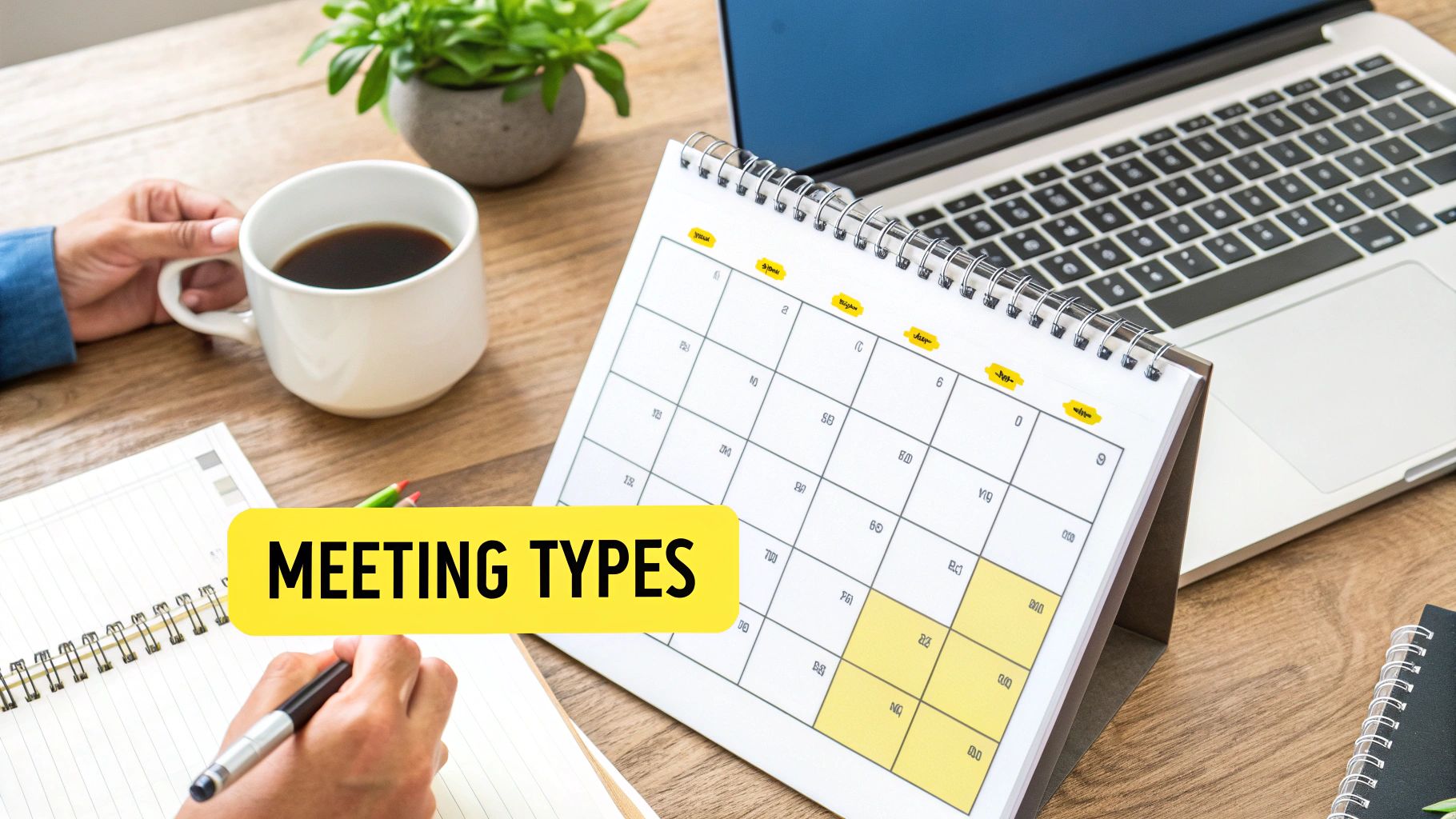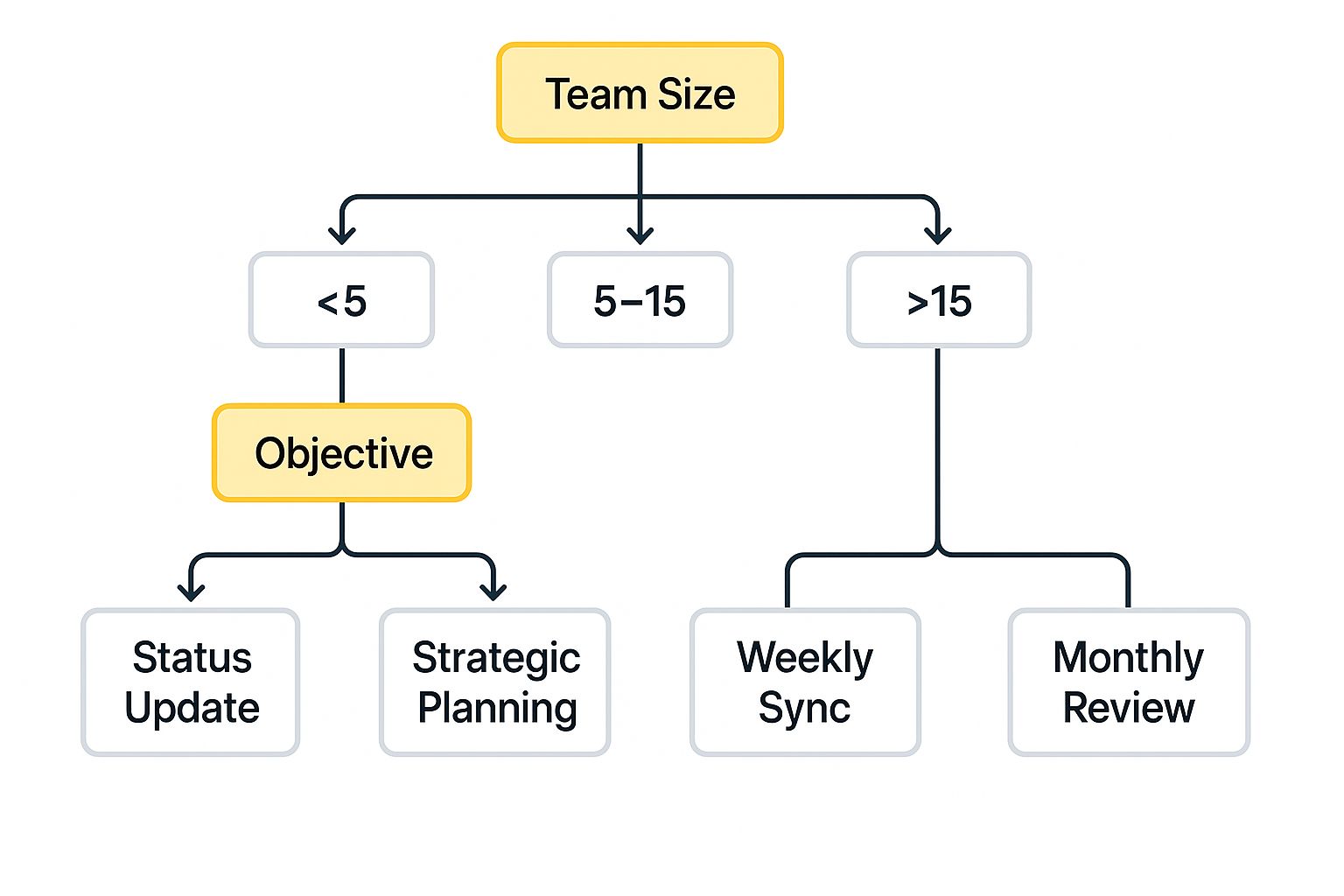Think of your team’s meetings like the rhythm section of a band. Without a steady beat, everything descends into noise. But with a consistent, predictable rhythm, you get music. That’s exactly what a meeting cadence is: the intentional, predictable rhythm for your team’s collaboration.
It’s the heartbeat that keeps everyone in sync.
The Heartbeat of Team Collaboration

A well-defined meeting cadence acts like a conductor, setting a consistent tempo for the entire group. It turns a calendar full of random, disjointed meetings into a structured framework for communication. Everyone on the team knows exactly when the key conversations are going to happen.
This rhythm is more than just scheduling; it’s a powerful tool for managing workflow, building trust, and driving accountability. When your team can anticipate the flow of information, they can plan their deep, focused work more effectively, free from the anxiety of wondering when the next interruption will hit.
Why One Size Fails Everyone
There’s no magic formula here—a “one-size-fits-all” meeting cadence is doomed to fail. Every team has its own unique pulse, and finding the right rhythm depends on a few key factors:
- Project Complexity: Fast-paced, agile projects often need the quick pulse of a daily check-in. On the other hand, long-term strategic initiatives might thrive on a slower, bi-weekly or monthly beat.
- Team Interdependence: How closely do team members need to work together? Tightly collaborative teams need more frequent touchpoints to stay aligned, while teams with more independent roles can get by with fewer meetings.
- Work Environment: The rise of remote and hybrid work has put a huge focus on cadence. It’s a constant balancing act between fostering connection and protecting uninterrupted focus time.
A great meeting cadence should feel natural and supportive, not rigid or restrictive. It’s about reducing uncertainty by making communication predictable so people can focus on what they do best.
Ultimately, the goal is to find that sweet spot between too much communication (hello, meeting fatigue) and too little (which leads to misalignment and silos). When you nail the cadence, it becomes far easier to figure out how to conduct productive meetings because the purpose and timing are already crystal clear.
To help you find your team’s rhythm, here’s a quick look at some of the most common meeting cadences and what they’re used for.
Common Meeting Cadences and Their Purpose
| Cadence | Common Use Case | Primary Goal | Best For |
|---|---|---|---|
| Daily | Stand-up or Huddle | Quick synchronization and obstacle removal | Agile development teams, fast-moving projects |
| Weekly | Team Sync or Check-in | Progress review, weekly planning, and alignment | Most functional teams (marketing, sales, operations) |
| Monthly | Business Review | High-level performance tracking and strategic adjustment | Department heads, leadership teams, stakeholder updates |
| Quarterly | Strategic Planning | Long-term goal setting, budget review, and big-picture alignment | Executive leadership, cross-departmental initiatives |
Each of these rhythms serves a distinct purpose, from the rapid-fire daily huddle designed to clear blockers to the slower, more reflective quarterly session for big-picture strategy. Choosing the right mix is the key to creating a sustainable and productive flow for your team.
The True Cost of a Broken Meeting Rhythm
An inconsistent meeting rhythm isn’t just annoying—it’s a silent saboteur of your team’s potential. Picture a team calendar that’s a constant game of Tetris, crammed with back-to-back, reactive meetings. There are no predictable check-ins, only last-minute summonses that shatter concentration and yank people out of deep work.
This kind of environment creates a destructive ripple effect. Without a steady beat to work to, communication falls apart. This leads directly to duplicated work, missed deadlines, and a constant feeling that no one is on the same page. People spend their days reacting to calendar invites instead of proactively driving their projects forward.

The Staggering Price of Unproductive Meetings
The damage from a broken meeting rhythm isn’t just a feeling; it has a massive financial and human cost. When meetings have no clear purpose or predictability, they become one of the biggest drains on a company’s resources. The numbers are pretty grim.
Businesses lose an estimated $34 billion annually because of unproductive meetings. Employees waste around 31 hours every month in sessions they feel are pointless. It’s even worse for leadership—managers already spend over 50% of their workweek in meetings, a figure that’s only expected to climb. All that context switching and lack of focus time leads straight to burnout and disengagement. You can find more stats like these in these workplace communication trends on pumble.com.
This financial drain isn’t a passive problem. Ignoring your meeting cadence is an active choice to accept inefficiency, tank morale, and bleed money.
A broken meeting rhythm is like a hidden tax on your team’s productivity. It quietly drains time, energy, and money, leaving everyone overworked yet underperforming.
From Burnout to Breakthroughs
Maybe the most insidious cost of a poor meeting cadence is how it completely destroys deep work. When every day is a frantic scramble of ad-hoc meetings, the focused, strategic thinking needed to solve tough problems becomes impossible. This constant interruption breeds a culture of shallow work, where teams are always busy but rarely productive.
It creates a predictable—and damaging—cycle:
- Widespread Burnout: Employees feel perpetually overwhelmed, never able to make real progress on their most important work.
- Plummeting Productivity: With no protected time for deep work, project timelines stretch out, and the quality of work suffers.
- Costly Delays: Misalignment and bad communication lead to rework and missed deadlines, which directly hits revenue and client satisfaction.
The first step toward a fix is to start treating your meeting cadence as a strategic imperative. It’s about reclaiming your team’s most valuable resources—their time and focus—and building an environment where people can actually get things done. Getting this rhythm right isn’t just a nice-to-have; it’s a critical strategy for survival and growth.
Why a Deliberate Cadence Drives Better Results
Moving beyond just putting out fires, a deliberate meeting cadence actively builds a more resilient, focused, and effective team. When you establish a predictable rhythm, you’re not just organizing calendars; you’re creating the very foundation for peak performance.
It’s the difference between a team constantly reacting to emergencies and one that moves forward with confidence and clarity.
This consistency fosters a powerful sense of predictability. Your team can structure their entire week around known touchpoints, carving out protected time for deep, focused work without the fear of random interruptions. A reliable weekly check-in, for example, empowers them to plan their tasks knowing exactly when they’ll need to report progress.

From Chaos to Clarity
A well-designed cadence systematically stamps out ambiguity and rallies the entire team around shared goals. Information stops trickling down through messy backchannels or getting lost in cluttered inboxes. Instead, it’s shared consistently and openly at designated times.
This rhythm builds momentum and reinforces accountability almost by itself. When everyone knows a project update is scheduled for the same time every week, they are far more likely to stay on track. This proactive alignment prevents small misunderstandings from snowballing into major roadblocks, saving a ton of time and resources down the line.
The core benefits are crystal clear:
- Radical Team Alignment: Everyone is finally operating from the same playbook, with shared context on what matters most.
- Predictable Workflows: Individuals gain the autonomy to actually manage their schedules, which boosts productivity and cuts down on stress.
- A Culture of Accountability: Clear expectations and regular check-ins make it easier to track commitments and, just as importantly, celebrate wins.
The surprising outcome of a great meeting cadence is often having fewer meetings overall. By making each scheduled interaction more purposeful and effective, you eliminate the need for countless follow-up and “quick sync” meetings that torpedo the workday.
Boosting Morale and Engagement
A consistent meeting cadence also has a huge impact on team morale. It signals respect for everyone’s time and provides a stable framework in what can be a chaotic work environment. That stability reduces anxiety and helps build psychological safety, making team members feel more connected and in the loop.
Ultimately, this structure transforms meetings from a necessary evil into a valuable tool for collaboration. When teams are in sync, they’re more engaged and motivated. For teams looking to capitalize on this, exploring different meeting engagement ideas can turn a good cadence into a great one.
The result is a positive feedback loop: better meetings lead to better work, which in turn boosts morale and drives project success.
How to Design the Right Meeting Cadence for Your Team
Moving from theory to practice, designing the right meeting cadence is less about grabbing a template and more about playing detective. You have to investigate your team’s unique workflow, communication style, and project goals to build a rhythm that just fits.
A cadence that’s perfect for a fast-moving dev team will probably feel suffocating to a long-term strategic marketing group. The goal is to create a rhythm that feels supportive, not restrictive.
Start With Your Core Needs
Before you even think about putting something on the calendar, you have to nail down the “why” behind your meetings. A classic mistake is scheduling meetings just for the sake of it, which leads to calendar bloat and a team of zombies.
The data backs this up. One survey found that 24% of professionals see too many meetings as their biggest productivity killer. And while 46% of meetings are for project status updates, only 54% of people leave knowing what to do next. That’s a huge disconnect. You can dig into all the details in these meeting statistics from bettermeetings.expert.
Frequency alone doesn’t get results. A great meeting cadence is built on purpose, not just presence.
To sidestep this trap, figure out what specific problems you’re trying to solve:
- Is information getting lost in the shuffle? You might need more frequent, shorter check-ins.
- Are we drifting apart on long-term goals? A slower, more strategic monthly or quarterly rhythm could be the answer.
- Are team members getting stuck waiting on each other? A daily stand-up might be what you need to clear those roadblocks fast.
Choosing Your Rhythm
Once you’re clear on your objectives, you can start matching them to a specific cadence. Things like team size, project complexity, and your overall work style play a huge role here. Agile teams working in sprints have totally different needs than teams managing long, sequential projects.
This decision tree infographic breaks it down nicely, showing how factors like team size and meeting goals can point you to the right cadence.

As you can see, a small team focused on quick updates is a great fit for a daily huddle. A larger team focused on high-level strategy? They’re better off with a monthly review. Use this as a guide to frame your thinking.
Thinking about the most common cadences—daily, weekly, and monthly—can help clarify which is the best fit for your team’s immediate needs. Each has its own strengths and weaknesses depending on what you’re trying to achieve.
Choosing Your Cadence: Daily vs. Weekly vs. Monthly
| Factor | Daily Stand-up | Weekly Check-in | Monthly Review |
|---|---|---|---|
| Primary Goal | Unblock immediate issues & sync daily tasks | Track weekly progress & align on priorities | Review long-term goals & strategic alignment |
| Best For | Fast-paced, agile teams with high interdependency | Teams with independent workstreams needing coordination | Leadership, strategic planning, cross-departmental teams |
| Meeting Length | 15 minutes (max) | 30-60 minutes | 60-120 minutes |
| Pace of Work | Very rapid, sprint-based | Moderate, project-based | Slower, goal-oriented |
| Potential Downside | Can interrupt deep work if not managed well | Urgent issues might wait too long to be addressed | Too slow for tactical problem-solving; risks losing momentum |
This table isn’t about finding a single “right” answer. Most high-performing teams use a blend of these cadences for different purposes.
The best meeting cadence is a living system, not a static rule. It should be revisited and refined as team dynamics, projects, and organizational goals evolve.
Finally, always consider the trade-offs. A daily stand-up is amazing for real-time problem-solving but can kill deep work. A monthly review is great for the big picture but useless for urgent blockers. It’s all about finding the right balance that helps your team without creating friction.
Proven Meeting Cadence Examples in Action
Theory is one thing, but seeing how a meeting cadence works in the real world is where it all clicks. The best rhythms aren’t one-size-fits-all; they’re shaped around the unique flow and demands of a team’s work. Let’s walk through a couple of proven examples you can steal from and adapt.
Think of these not as rigid rules, but as blueprints for building predictability and focus. Each one is designed around a team’s core function, showing how different cadences support different goals.
The Fast-Paced Software Development Team
An Agile software team lives and breathes in short, iterative cycles called sprints. It’s a constant loop of build, test, and learn. Their meeting cadence has to match that rapid pace, focusing on daily alignment and weekly progress reviews to keep the train moving smoothly.
This dual rhythm—daily syncs and weekly retrospectives—is the engine that powers continuous improvement.
- Meeting 1: Daily Stand-Up
- Purpose: To quickly flag and smash any immediate blockers, keeping the team totally in sync on what needs to happen today.
- Attendees: The core development team, Scrum Master, and Product Owner.
- Duration: 15 minutes. No exceptions.
- Agenda: Each person answers the classic three questions: What did I get done yesterday? What am I tackling today? What’s standing in my way?
- Meeting 2: Weekly Sprint Review
- Purpose: This is the “show and tell.” The team demonstrates what they built during the sprint, gets crucial feedback from stakeholders, and adjusts the product backlog based on what they learn.
- Attendees: The entire development team plus key stakeholders.
- Duration: 60 minutes.
- Agenda: It usually involves a live demo of new features, a frank discussion of what worked (and what didn’t), and a look at key metrics. For a detailed guide, check out our post on creating an effective sprint review meeting agenda.
The Strategic Marketing Team
A marketing team has a different puzzle to solve. They’re juggling long-term campaigns with the need to react to short-term analytics and make quick pivots. Their cadence needs to balance tactical, in-the-weeds execution with high-level performance analysis. It’s all about making sure their efforts are always tied to real, measurable results.
This rhythm allows the team to be both responsive and strategic. Weekly syncs keep campaigns on track day-to-day, while monthly deep dives ensure their efforts are driving real business growth.
Their structure often breaks down like this:
- Meeting 1: Weekly Campaign Sync
- Purpose: To check the pulse of active campaigns, make sure cross-channel efforts are aligned, and solve any immediate problems getting in the way of execution.
- Attendees: Campaign managers, content creators, social media specialists, and a team lead.
- Duration: 45-60 minutes.
- Agenda: A quick review of the key performance indicators (KPIs) from the past week, confirming priorities for the upcoming week, and assigning clear action items.
- Meeting 2: Monthly Performance Review
- Purpose: Time to zoom out. This meeting is for analyzing campaign results against monthly and quarterly goals, sharing strategic insights, and planning the big moves for the month ahead.
- Attendees: The entire marketing team and the department head.
- Duration: 90 minutes.
- Agenda: A deep dive into the analytics, a discussion of major wins and lessons learned, and brainstorming for future campaigns. This is where the team steps back from the daily grind to see the bigger picture.
How to Implement and Evolve Your Meeting Cadence
Putting a new meeting rhythm on the calendar is easy. Making it stick and actually deliver value? That’s where the real work begins. Rolling out a new cadence is much more than sending a bunch of invites; it’s about communicating the why behind the change. Everyone needs to understand what you’re trying to achieve and what’s expected of them.
A great first step is to document the purpose, attendees, and general structure for each meeting in your new rhythm. When you’re transparent, you manage expectations from the get-go and get everyone on board much faster. The goal is to make the new cadence feel like a supportive framework, not just another rigid rule dropped from above.
Launching and Sticking the Landing
To make sure the new rhythm sticks, consistency is everything in the beginning. Think of the first few weeks as a critical adoption period where you’re building new habits as a team. This means you have to protect that scheduled time and hold every meeting to its stated purpose and duration.
Standardized agendas are your best friend here. They keep discussions focused and make sure every meeting delivers on its promise, whether it’s a quick daily sync or a longer monthly review. You can find some great team meeting agenda examples to get a head start on creating effective, repeatable structures.
A meeting cadence is a living system, not a static rule set in stone. Its purpose is to serve the team, so it must be flexible enough to adapt when the team’s needs change.
Listening for the Warning Signs
Once you’ve launched the cadence, your job shifts from implementation to observation. A healthy meeting rhythm should feel energizing and productive, but you need to keep an eye out for signs that it’s starting to drift off course.
These are common red flags that your cadence needs an adjustment:
- Declining Engagement: Are people showing up unprepared, multitasking like crazy, or just staying silent? That’s a huge indicator that they don’t see the value anymore.
- Meetings Run Long: If your meetings consistently spill over their time slot, it could mean the agenda is too packed or the frequency is off. Maybe that weekly meeting needs to be 45 minutes instead of 30, or maybe it needs to happen twice a week.
- Decisions Aren’t Sticking: This is a big one. When action items from meetings get forgotten or ignored, the cadence has lost its authority and is just becoming a waste of time.
Don’t wait around if you spot these issues. The only way to keep a cadence healthy is to treat it like any other process in your business—something you should actively seek to improve.
Evolving Your Rhythm with Feedback
Your meeting cadence must evolve along with your team. The absolute best way to guide that evolution is by actively asking for feedback and running periodic “rhythm retrospectives.”
Every month or quarter, set aside a few minutes to ask the team some direct questions. What’s working well? Which meetings feel redundant or useless? What could we do to make our time together more valuable? This collaborative approach makes the team co-owners of the cadence, ensuring it continues to support their work instead of getting in the way.
Frequently Asked Questions About Meeting Cadence
Even with a perfectly mapped-out plan, you’re bound to hit a few practical questions when rolling out a new meeting rhythm. Getting ahead of these common concerns helps your team navigate the change smoothly, ensuring the new cadence feels like a support system, not another hurdle.
Let’s dig into some of the questions that pop up most often.
How Do You Adjust Cadence for Remote Teams?
For remote or hybrid teams, a predictable meeting cadence isn’t just nice to have—it’s essential. It’s what you build your communication and connection on. The real trick is to be deliberate about replacing all the informal, “water cooler” talk that happens naturally in an office.
Lean towards shorter, more frequent check-ins to keep everyone in the loop. For example, a daily asynchronous update in a chat channel is a great stand-in for those casual desk-side chats. When you do schedule live meetings, be thoughtful about time zones. If your team is spread out, rotate the meeting times so the same people aren’t always stuck with the early morning or late-night slot.
For distributed teams, a strong meeting cadence is the architecture of their collaborative culture. It intentionally carves out time for both project updates and relationship-building, ensuring every team member feels included and informed, regardless of location.
What Is the Difference Between Cadence and Agenda?
It’s easy to get these two mixed up, but they handle very different jobs. Think of it like planning a cross-country road trip:
- Meeting Cadence is your plan for when and how often you’ll stop for gas—say, every 200 miles or at the start of each day. It’s the consistent rhythm of your journey that ensures you never run out of fuel.
- Meeting Agenda is the what you do at each stop. It’s the specific to-do list for that particular stop, like checking the oil, grabbing snacks, and cleaning the windshield.
A great cadence makes sure you meet at just the right intervals. A great agenda makes sure you actually get something done when you do. To make your agendas more powerful, you’ll find some great tips in our guide to meeting minutes best practices.
How Long Should We Test a New Cadence?
Whatever you do, don’t scrap a new cadence after one awkward meeting. It’s tempting, but any new rhythm needs time for the team to settle in and find their groove.
As a rule of thumb, give any new meeting cadence at least one full project cycle or a month, whichever is longer. If you’re trying a weekly meeting, that means holding at least four or five of them before you pass judgment. This gives you enough real data to spot actual patterns, not just first-day jitters.
Once the trial period is over, schedule a dedicated feedback session. Talk openly about what’s working and what isn’t, and make your adjustments together.
